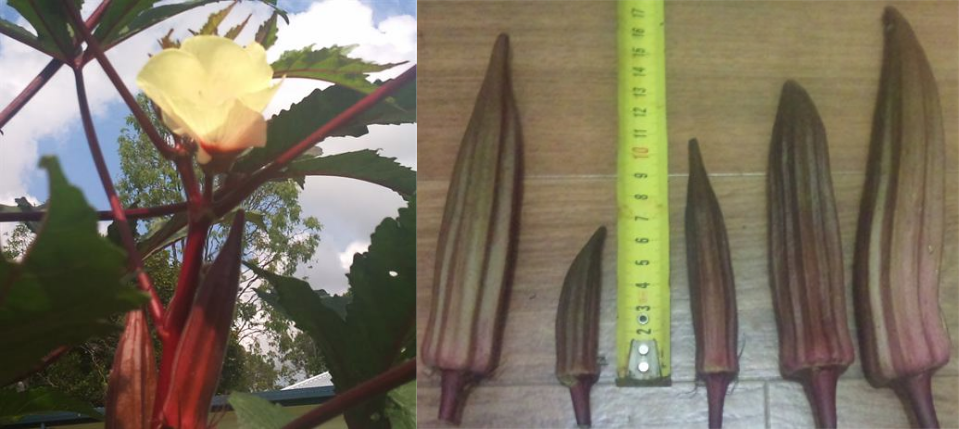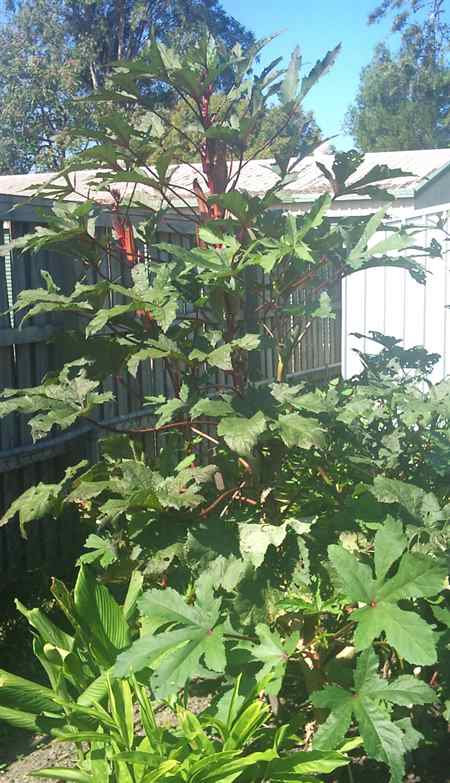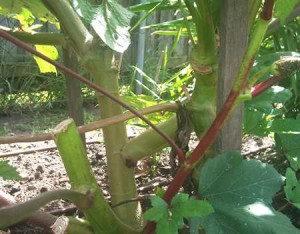Although this stuff is easy to grow and also gives a good harvest, you have to have an acquired taste for it. I know there are millions of people in places like India and the south of the USA, Vietnam and other tropical Asian and African countries. To me, it ranks with tripe, at the bottom of the food chain.
Sure you can add it to salads and curries and gumbo, but it is slimy and tastes like shite.
I was at Bunnings and saw a couple of guys from the sub-continent looking at some Okra seedlings. I had grown it before but never eaten it so I needed to see what would happen. The last time I grew it was in South Australia and they were picked by a Vietnamese friend and prized. I was happy that someone enjoyed them.
The climate in Qld is the opposite to SA. It rains in summer here and winter in SA. They have very hot dry summers, here has hot humid summers with most times a lot of rain.
So I bought a couple of different types, took them home and planted them.
Okra pruning required
Boy can they grow. Before long, it looked like I was growing a couple of trees in the middle of the garden. They were out of control. They were in a bed that I had previously grown mung beans, so I was wondering if they had an affinity to the root dwelling bacteria that beans attract. These bacteria live in nodules in the roots and convert nitrogen from the air into a form that feeds the plant. In return the plant excretes a sugary substance from its roots that feed the microbes.
They started producing fruit after a flower appeared for at most a day before closing again. Being me, I thought the bigger the better. Wrong, I had to pick them early, when they were no bigger than my pinkie. After that they started to go fibrous and woody.

Beautiful Flower, open for a day and plenty of fruit but only edible when tiny. The small one is the right size
Okra in a Curry
So we tried some in a curry and both of us thought it was nothing to write home to mum about. In fact it didn’t rank for taste or texture. I am willing to admit that we don’t know how to cook it or present it.

Large Okra left, small Okra right. Cut in half. The bigger the seed the more mucousy substance in them and the more fibrous the pod.
Armed with this thought that I didn’t know enough about it, I was on the lookout for a neighbour who is Indian. I’d never met them so the next time I saw them outside, I was in the garden. I cut off a couple of the fruit and jumped a couple of fences to say hullo and get some knowledge. Unfortunately I had collared mother or maybe grandmother, who didn’t speak any English. She must have been wondering who this crazy old bloke was that jumped the fence and was waving some Okra in her face.
After about 30 seconds, she grabbed the Okra said thank you and disappeared inside. I haven’t seen an appearance of the neighbours two doors up since. So I am no wiser to the attributes of Okra.
About the only thing of value that it was doing was shading the ginger. We have had a very hot summer and the Okra was helping the ginger by shading it.
When Autumn arrived, I made the grand decision to remove the Okra, It wasn’t as difficult as I imagined it would be. I cut it down to size with my Silky Sugoi and pulled it out.
My original supposition was correct. The roots, which were quite long but set shallowly were covered in nodules. They were not nematode nodules as the plant was way too vigorous. I chopped off all the roots and buried them back into the garden. Unfortunately I didn’t think to get a picture of the nodules and I don’t think I will be growing Okra again, just for the chance of taking a picture of the nodules.
To give you an idea what the bacteria nodules on a root system look like go to this post Soy Beans and Nitrogen Fixing Bacteria
I know that I am ignorant when it comes to Okra. If you feel that I need enlightenment, I am ready to listen. Leave a comment or a recipe, I am only too pleased to try it out and maybe change my opinion.
Cheers Olman



Bhindi( OKRA) Masala (Dry) Recipe (with Step by Step Photos)
(5 Votes and 6 Comments)
Bhindi Curries, Curries, Lunch, Punjabi
This is one of the most widely followed Indian bhindi curry preparations. This easy Punjabi style bhindi masala recipe has dry texture and requires shallow frying bhindi followed by mixing with spicy dry masala of onion and common curry spices. Look at the tips and variations given below to customize it your preference.
‹›
Punjabi Bhindi Masala Dry
Preparation Time: 10 minutes
Cooking Time: 15 minutes
Serves: 2 servings
Print Recipe
Cooking Measurements
Bhindi Masala (Dry) Recipe In Hindi (हिन्दी में पढ़े)
Ingredients:
250 gms (1/2 lb) Bhindi (Ladies Finger/Okra)
1 medium Onion, finely chopped
2 teaspoons Cumin-Coriander Powder
1/4 teaspoon Turmeric Powder
1/2 teaspoon Garam Masala
1 tablespoon grated Coconut
1-2 Green Chillies, deseeded and chopped
1 teaspoon Ginger, finely chopped
4 cloves Garlic
1/2 teaspoon Cumin Seeds
2 tablespoons Coriander Leaves, finely chopped
1½ tablespoon + 2 tablespoons Oil
Salt
Directions:
step-1
Wash bhindi in running water and dry them completely with cloth. If they are not completely dry, then they will turn sticky while cutting and cooking. Remove head and tail of it. Cut each one lengthwise and make long halves.
step-2
Coarsely crush green chilli, ginger and garlic in grinder and make spicy ginger-garlic-chilli paste.
step-3
Heat 1½-tablespoons oil in a frying pan over medium flame. Shallow fry cut bhindi over medium flame until it turns dark green and shrinks, approx. 6-8 minutes. Sprinkle some salt over it, stir and cook for a minute. Turn off the flame and transfer to a plate.
step-4
Heat remaining 2 tablespoons oil in pan. Sauté cumin seeds in it; when they begin to crackle, add green chilli-ginger-garlic paste (prepared in step 1) and sauté for a minute.
step-5
Add finely chopped onion and mix well. Sprinkle salt (only for onion) and cook until it turns light brown.
step-6
Add turmeric powder and garam masala, mix well.
step-7
Now add shallow fried bhindi and cook for a minute.
step-8
Add grated coconut, cumin-coriander powder and mix well.
l_step
Turn off the flame and transfer prepared curry to a serving bowl. Garnish bhindi masala dry with coriander leaves and serve hot.
Tips and Variations:
Wash and dry bhindi 3-4 hours before cooking to prevent them turning sticky while cooking.
Shallow fry finely chopped potatoes (1 medium size) along with bhindi to make delicious variation.
Add finely chopped tomatoes in curry (after onion turns brown) for tangy flavor.
Add 1/2 teaspoon sugar and 1 teaspoon lemon juice in step-8 to make irresistible mild sweet and sour Gujarati style dry masala bhindi.
Taste: Spicy
Serving Ideas: Punjabi dry bhindi masala, tandoori roti, steamed rice or peas pulao and cucumber tomato onion salad makes a healthy wholesome meal. Serve it in parties as main curry dish.
Author: Foram
Hi Olman
You can try above, if you don’t like spices then just use okra, onion and salt just follow the steps and you will find Okra wothout slimy I put some fresh lemon juice 2 spoons in okra and with lemon okra is not slimy.
You will love it if you liked this one then search for fry whole stuffed bhindi(OKRA) online.
Enjoy
Hi Hardeep,
thanks for taking the time to share your information and recipe.
appreciated Olman
Sorry I submit twice by mistake.